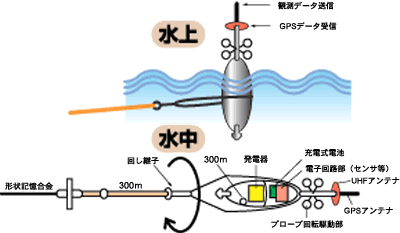| Japanese / English | |
HOME >> Nature Interface 2001.3: Special Features >> The Future of Whales
|
||||||||||
|
||||||||||
The Future of Whales TOMONAO HAYASHIProfessor, Chiba Institute of Technology NI; What were the impressions of students who worked on the manufacture of the WEOS? H: Since the range of this theme is wide, about seven to ten students studying electronics, electrical engineering, mechanical engineering, and industrial design study this theme for their graduation theses every year. The objective of this study is very clear, so the students enjoy and are greatly interested in the research. Of course, the satellite is assembled at a professional manufacturing corporation, but the students are happy to do the basic experiments needed for making the satellite system. To reduce the budget for developing a satellite is most important as an activity in a university. In the field of space development, however, high reliability is required for satellite parts. Parts called "high-reliability components" are usually used, about which people can obtain such data as where, how, and by whom the part was made at any time. But such components are quite costly. So we decided to use the parts for consumer electronics after careful selection and tests: their quality is guaranteed only for use under the standard atmospheric pressure, which is 1 atm (1013.25 hPa). It was necesary for us to determine if the product we were adapting for parts would bear the shock of launching and of space radiation. We often went to JAERI Takasaki (Japan Atomic Energy Research Institute in Takasaki) for experiments using radiation. As for the development of the probe, we also went to an organization which has a large pressure-tank for underwater experiments 
NI; What were your new findings? H: We learned a great deal about the ecology of whales from Mr. Seiji Osumi at the Institute of Cetacean Research. There were many people who helped us. We are planning to realize the attachment of a probe to a whale in a minimally invasive way. We needed to control the pressure of an airgun with which the pin enters, so that it does not go deeper than the blubber, and so that the whale won't be injured. For this objective, we collected basic data on how much the gas pressure or the weight of the pin should be, by analyzing the thickness and features of the skin of each of the whale species. It's quite hard to get the skin of whales, but whales sometimes make stranding. When a sperm whale went aground at Shizuoka Prefecture in Central Japan last year, I heard on TV at night that the whale would be scrapped on the following day. So I rushed to Tokyo Station, and went to Shizuoka by the first bullet train the following morning. In this way, I got the skin of that whale. At first, I heard it would be good to shoot a light pin with high speed. But this method didn't work: the pins rebounded or bent. We came to understand that the proper weight was necessary. We attached an iron shaft on the tail of a pin. The shaft is so designed as the pin is attached on the skin. Baird's beaked whales dive to the depth of 1000 m (0.6 mi), and their skin is hard, probably so that they can bear high water pressure. Therefore, we thought it would be difficult get the pin to attach, but in fact it was easy, once we weighted the pin a little. In contrast, we thought it would be easy to get the pin to stick into the skin of minkes, because their skin is soft. But actually, it was not very easy. Minkes dive to the depth of only 100 m (0.06 mi), so they don't need to bear heavy water pressure, and yet it's important for them to not let their skin be bitten by enemies. These issues were quite interesting for me. People only thought about catching whales before, and never thought about the quality of their skin. These issues were discovered through drop tests of a pin done by the students of the Department of Mechanical Engineering. The influence and availability of the pins were observed by attaching them into bottlenose dolphins for a two month period. We didn't find any problems in this experiment. For this we had the help of Mr. Akio Tobayama, of Kamogawa Sea World. << back (2/3) next >> |
|Top of this Page|
©2000-2001 Nature Interface. corporation allrights reserved
